Fidelio may well be the first "mind-splitting" opera in the music canon. The listener exits the theatre in full knowledge that he has experienced something profound, a plunge into the great pool of universal themes and eternal ideas. On the other side of his brain, however, there lingers a feeling of absence, as if the magic and absorption that only theatre can generate were not fully there. The opera's problems range from historical context to dramaturgy and style. The vicissitudes of Napoleonic rule in the decade of Fidelio's compositional history are reflected in the shift from a story of personal rescue to one closer to political activism.1Particularly striking is the stylistic distance between the opening numbers and the advanced idiom used in the dungeon scenes. Indeed, Act I forms a long trajectory whose beginning and end could easily have come from different operas. Leonore identifies herself too late for us to embrace her cause and Marzelline practically disappears in Act II. There are also implausibilities that one can hardly ignore. Fidelio is employed in a high-security prison even though he has no past. Florestan, a man starving to death, sings a solo aria for eight minutes, and poor Marzelline is forced to join in a finale that marks the end of her happiness. As for the contemplative ensembles of the canon quartet and the "Augenblick" section in the finale, these may work wonders in Beethoven's instrumental music,2 but on the stage, where things have to move constantly, they can spoil continuity and undermine theatrical illusion. Not to mention that, in a prison, the luxury of contemplation is reserved for the incarcerated alone. Because of these problems, Fidelio is hardly ever adored, although it will always be admired. And its well earned reputation as a masterpiece comes hand in hand with open acknowledgements of its flaws, as in Winton Dean's assessment: "Fidelio, whatever its faults, is a great opera and a work of theatrical genius."3
One way to come to terms with or cast a different light on some of these problems would be to move beyond textual and musical content, and reach a level that naturally promotes the opera's dramatic unity, and this is plot, the heart and soul of any drama as Aristotle affirmed centuries ago. Whatever the differences between the libretto and music, poetic imagination and musical portrayal may be, it is always the logical succession of events leading to a final goal that makes drama work. In Fidelio, the goal is the reunion of a violently separated couple and it is reached through a series of dramatic pairings, close associations in thought and action between individual characters. Studying the opera through these successive pairings can promote a deeper appreciation of its dramatic unity and, in the very least, will make visible the alignment between its theme and method.4 If Leonore is to restore her marital bonds with Florestan, she has to engage in dramatic fornication, so to speak, with other characters.
To begin with I will discuss the dramatic topography of the opera and describe individual characters in their successive "pairings." Table 1 logs their interactions, given in red typeface. Black type indicates only stage presence and roman/italic differentiation stands for sung and spoken parts, respectively. The opera features seven individual characters within two plots, a domestic/private one revolving around the anticipated marriage of Marzelline and Fidelio; and a political/public one centering on the murder of a prisoner, Florestan. With the exception of Rocco and Leonore, each character is assigned to a single plot.
Table 1
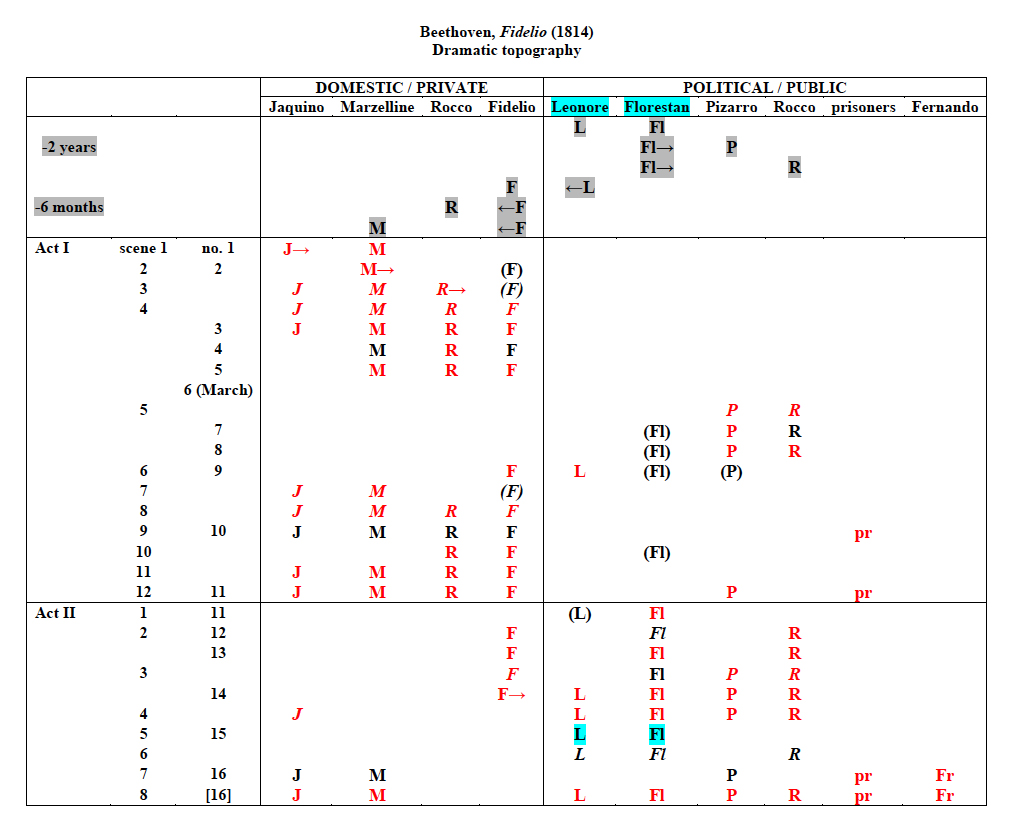
Rocco is the dramatic pivot in the opera allowing switches from one plot to another because of his dual role as father and prison keeper. By allowing Fidelio, his expected son-in-law, to accompany him in the dungeon he makes possible for Leonore to unite with Florestan. His pragmatism is partly dictated by family responsibilities, namely finding a husband for his daughter Marzelline, and enables him to weather political changes and serve different masters (no political order exists without prisons). Whatever negative impression we get from his "gold" aria, we are gradually exposed to his fundamental humanity: he instantly refuses to commit murder, agrees to let the prisoners out of their cells, shows pity for Florestan's condition, and eventually sides with the reunited couple. In terms of authority, he is answerable only to Pizarro and controls all other characters as father, employer, and prison keeper. Although this is an opera about conjugal love, Rocco has to be single, presumably a widower, because of his pivotal role. We wouldn't have liked it, if Mrs. Rocco came out of the kitchen every now and then spoiling her husband's interactions with the other characters.
Leonore, too, participates in both plots, but unlike Rocco she uses a proxy, the fictitious Fidelio, to inhabit the domestic plot. As the female part of a virtuous couple she is Florestan's equal. Once her husband is dramatically silenced and socially feminized through incarceration, she assumes his sex and social freedoms to restore their union. As "Fidelio," she embarks on a rescue mission and manages to gain Rocco's confidence and win Marzelline's heart (intentionally I believe). In an inferior position to everyone except Jaquino and Marzelline, she delivers the opera's coup by confronting Pizarro and disrupts his abusive coupling with Florestan by relinquishing her Fidelio persona. Notwithstanding the reunion duet, her marital bonds with Florestan are restored only upon the removal of the chains that had kept him under Pizarro's authority. This is why the finale has to take place outside the dungeon.
Florestan is absent in Act I and remains a passive figure for the rest of the opera. His aria at the opening of Act II offers a psychological portrait for which Beethoven reserves his most advanced idiom in the opera. We understand that he opposed Pizarro but clearly not enough to secure his own safety. Even before the curtain rises, he is dramatically engulfed by Pizarro through illegal incarceration, the hybris that sets the opera in motion. In film parlance, Florestan is the "Rosebud," the thing or person that both Leonore and Pizarro are after. On a deeper symbolic level, he represents the highest attainment of humanity (witness the universal themes in his statements), which however is open to abuse and thus remains in constant need of protection.
Pizarro is the most powerful character in the opera; his aria, in the subgenre of the "revenge aria," prefigures the storm music in the "Pastoral" Symphony. As the representative of evil, he is incapable of relating to others except through hatred, fear, and violence. He develops a fixation on Florestan and, as with all perverted love, he prefers to slowly torture him rather than eliminate him. Only when he learns of Don Fernando's impending visit, does he resolve to murder the prisoner and, by the way, get rid of Rocco and Fidelio as material witnesses ("Die muss ich mir heute noch Beide vom Halse schaffen, damit Alles auf immer im Dunkeln bleibt"). The Pizarro-Florestan enforced union, the dramatic polarity in the opera, dissolves with the combination of Leonore's violent reclaiming of her husband and Fernando's political authority.
Marzelline is the lower reflection of the feminine in the opera, a simple-minded girl seeking material comfort and emotional security.5 Her attachment to Fidelio forms the pillar of the opera's domestic plot and her blind faith in him justifies Rocco's trust in his new employee. If Jaquino exists at all, it is so that he replaces Fidelio in Marzelline's heart (or at least bed) when Leonore reunites with Florestan. Table 2 offers a simplified version of these couplings.
Table 2
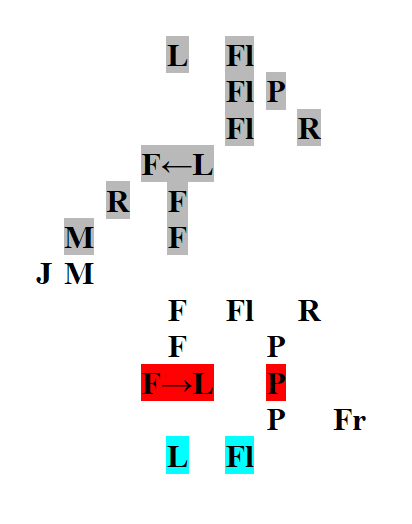
* * *
Studying an opera's dramatic pairings without broader considerations is a reductionist approach. It ignores layers of meaning that musicologists have come to value in the past three decades, such as historical setting, cultural context, genre, reception etc. We need to recall, however, that drama is reductive by its very nature, for it takes reality and refashions it to meet optimal cognitive settings. Thus a long chain of events is condensed to a three-hour spectacle and in such a way that it creates patterns of tension and release, climax and resolution. And human complexity is reduced to generic characteristics that are easily recognizable. We would not like to know of possible complications involving plot and characters, for example that Pizarro had been abused by Florestan's father when he was a young boy, or that Leonore might harbor resentment towards Rocco for endangering her husband's life. It is the reductive nature of theatre, then, that lends itself to this hermeneutic response.
What are the benefits of a systematic and rigorous examination of couplings in an opera? I will leave aside evident pedagogical uses, especially in introductory opera courses. For scholarly purposes, it could offer something akin to Schenkerian analysis, helping us identify layers of dramatic significance and develop a unitarian approach to music drama. To give an example, the Leonore-Florestan couple can be seen as the Ursatz in Fidelio, their separation and reunion forming the conceptual frame within which the opera runs its course. Pizarro introduces a long span of dominant, his horrid actions calling for dramatic resolution, whereas Rocco and the entire domestic plot function as dramatic prolongation, with Marzelline and Jaquino, the least necessary characters, standing as his own neighbor-note prolongation (we are dissatisfied with the opera's frivolous beginning because their comic duet stands the furthest away from the main plot).
Another benefit of this approach is that it encourages the construction of dramatic genealogies, namely who relates to whom and at which point. This helps us situate an opera's plot within a network of logical interactions and thus evaluate its dramatic strength. We can identify its starting point and missing steps in the unfolding of action (drama is so much about cut and paste). We can also clarify relationships that otherwise would have remained ambiguous. To give an example, in Fidelio we are not exactly sure about the hero's past with Marzelline. Did "he" actually flirt with her? Was there a kiss, perhaps? Or did Marzelline misconstrue "his" friendly attitude? A reconstruction of the story's beginning suggests that Fidelio had to approach Marzelline in order to gain Rocco's full trust; otherwise Marzelline is dramatically redundant. Confirmation that their dramatic association was not accidental we find, of course, in the earlier versions of the opera, Leonore, in which the two characters have a duet and extra dialog, not to mention that Marzelline's aria is the opening number in the opera.
Exploring dramatic pairings has another benefit. By privileging function over content, it helps us to detect surrogate characters more easily through what can be called "dramatic overshadowing." In a dramatic association of two characters, the stronger one can project his thoughts and emotions through the weaker one. Let us continue with Marzelline. It is worth asking how a girl of her social status and mindset can be as musically assertive as she is in the C-major section of her aria: (Example 1: Act I, no. 2, Arie: "O wär ich schon mit dir vereint"). Marzelline's vocal display belies her secondary role in the drama. Even more strange is that she gets Beethoven's favorite key, C minor moving to C major, an original compositional choice, according to Philip Gossett.6 This key aligns her with the three "Leonore" overtures and the opera's finale. And the prominence of the oboe in the C major refrain creates links with Florestan's aria, in which the instrument stands for Leonore, and with the couple's reunion at the "O Gott! Welch Augenblick" tableau vivant. This musical armory is too heavy for the marital aspirations of Marzelline, but it suits perfectly well Leonore. Unable to express her real emotions for Florestan before Marzelline, Leonore channels them through the latter's longing for marital happiness. A similar case is the famous chorus of prisoners, which gives voice to the absent Florestan.
Example 1
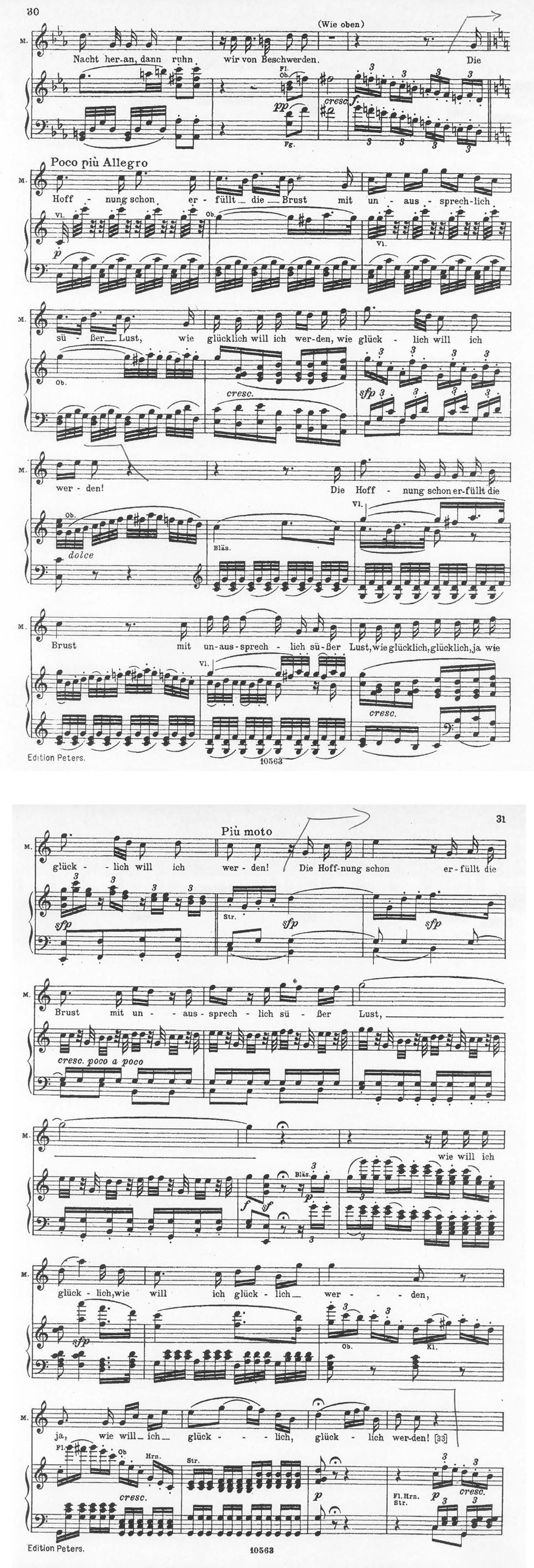
Example 1
Finally, studying dramatic pairing helps us revisit Fidelio as a modernized Orphean plot of loss, quest, and transformative recovery. As in the "Orpheus" legend, here too a perfect union is disrupted, forcing the active party to embark on a rescue mission for the lost one, which entails trials and a final confrontation, but finally leads to their reunion. Leonore and Florestan stand for Orpheus and Euridice, Pizarro combines the infernal authority of Pluto with the fury of Charonte, whose role as gate-keeper goes to Rocco. Marzelline's marital aspirations resemble Proserpina's earthly longings and Don Fernando clearly performs Apollo's role. Above all, Leonore's scenes in the dungeon evoke Orpheus' own descent to Hades.7 These similarities are hard to miss, especially after reading Owen Jander's work on Beethoven's Fourth Piano Concerto.8 One can even get a glimpse of Gluck's Orfeo in the furious choral passage in the opera's finale. (Examples 2-3: Beethoven, Fidelio, Act II, no. 16 "Finale" / Gluck, Orfeo ed Euridice, Act II, no. 23 "Misero giovane" and no. 28 "Dance of the Furies").
Examples 2-3
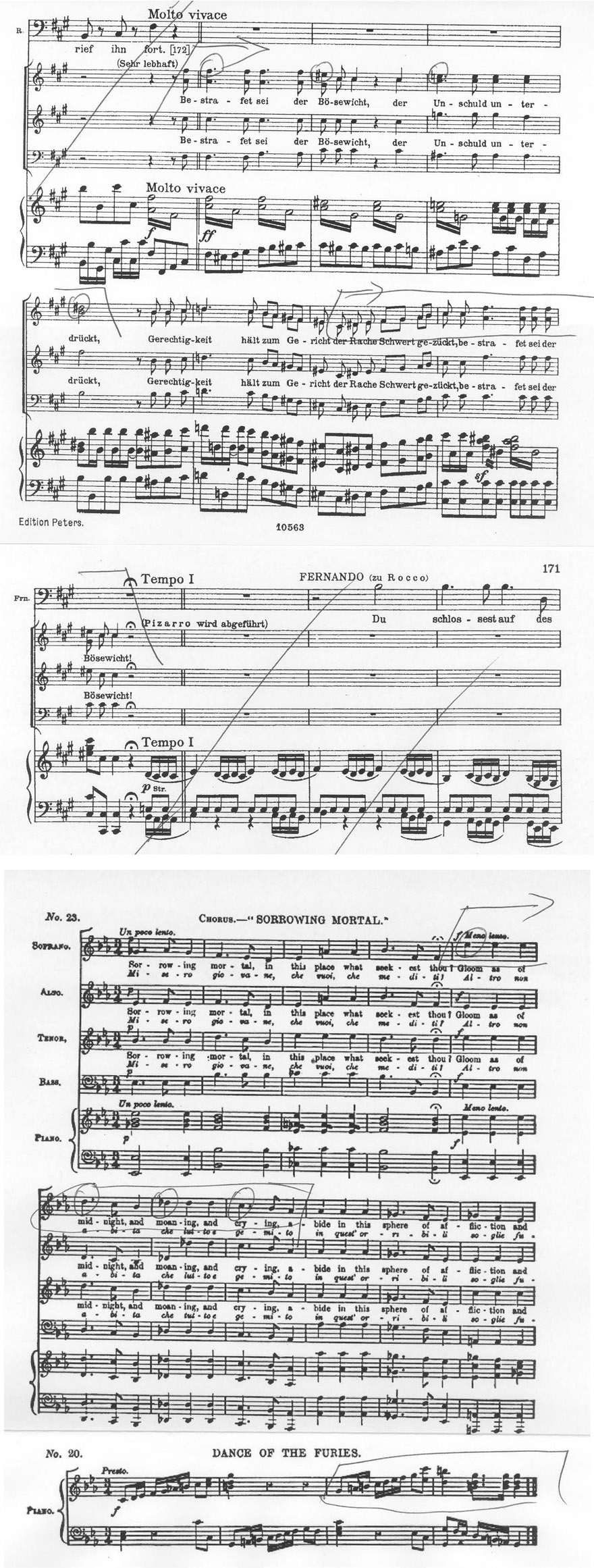 Example 2
Example 2
Example 3
Fidelio departs, however, from the Orphean model in significant ways. The hero is no longer sandwiched between Olympus and Hades, a plaything in the hands of gods. Although God is frequently invoked in the opera, everything happens entirely through human agency. Even the popular view of Don Fernando as deus ex machina is incorrect. We know of his imminent arrival already by the middle of Act I, thus the issue here is whether Florestan can be kept alive until Fernando arrives. Time, an element absent in the Orpheus legend, is of the essence, and Beethoven highlights it through the use of repeated triplets in Act II's "Melodram und Duett," in effect placing a clock in the middle of the stage. (Example 4: Act II, no. 12 Melodram und Duett: "Nur hurtig fort, nur frisch gegraben"). Nor is the trumpet signal as unexpected as it appears. We hear the B-flat only moments earlier, when Leonore discloses her identity. (Example 5: Act II, no. 14 Quartett: "Er sterbe! Doch er soll erst wissen"). Don Fernando only sanctions what could not have been possible without Leonore. Human agency, not divine will, is, therefore, the dramatic engine in Fidelio.
Example 4
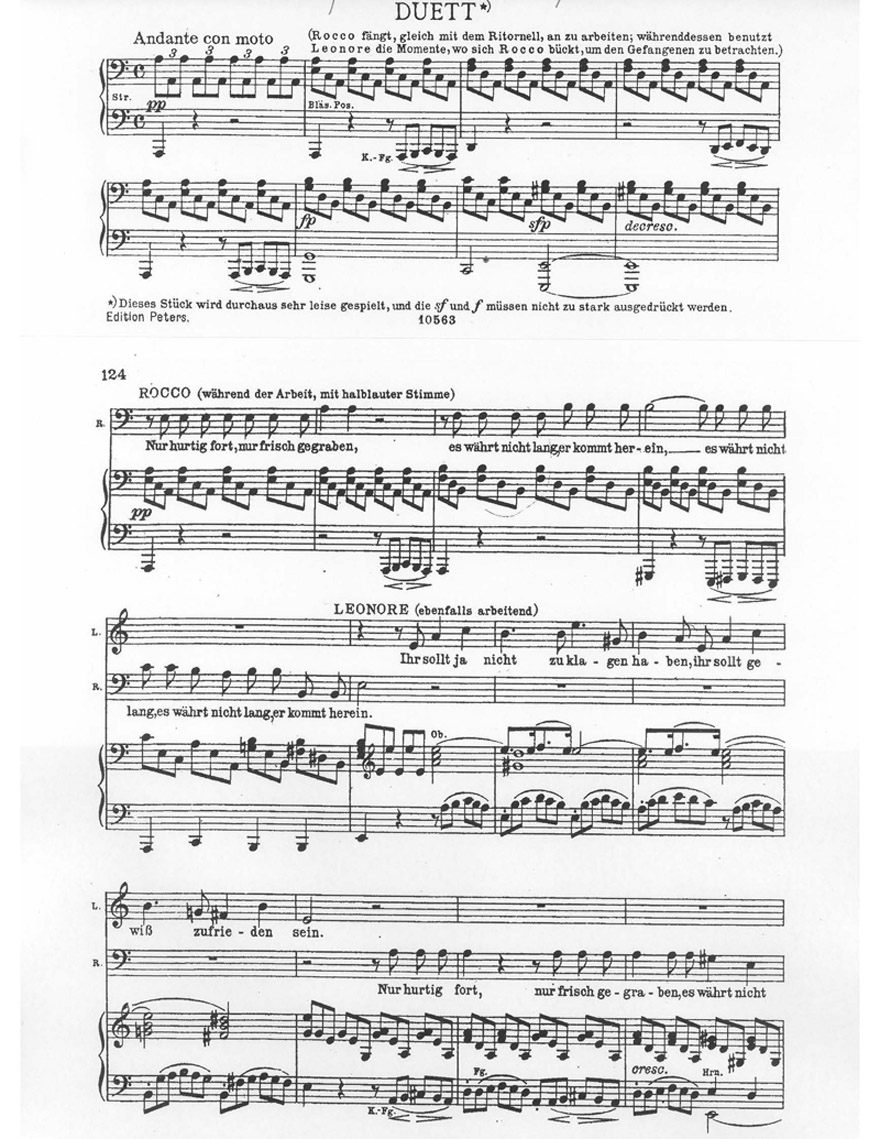
Example 4
Example 5
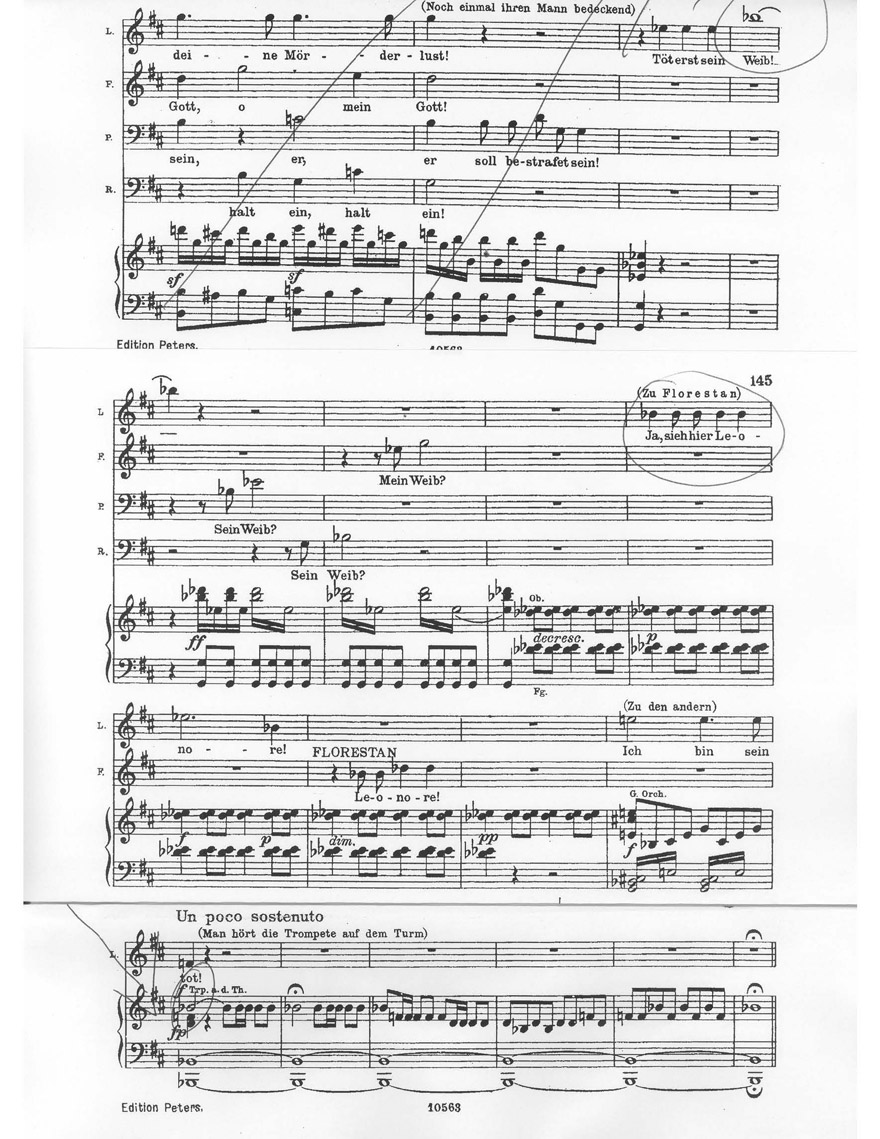
Example 5
Another difference is that Orpheus' erotic passion and artistic virtuosity are replaced by Leonore's courage, perseverance, discretion and fidelity. It took a little more than two years for her to find and rescue Florestan. Their coupling is much stronger than that of the Thracian bard and his bride. Moreover, the personification of evil in Pizarro allows for dramatic expansion. The bad guy appropriates the good guy, forcing the latter's spouse to confront him. This triangulation produces a dynamic setting that stands away from the Orphean solipsistic laments. And Don Fernando's Apollinian part becomes more integrated if we consider him as Pizarro's partner-in-law. Thus the reunion of Leonore and Florestan is counterbalanced by the appropriation of the evil-doer by his supervisor. With Marzelline not unexpectedly going to Jaquino, the plot of Fidelio ends with three sets of couples, whose respective partners deserve one another. As the opera's dramatic pivot, Rocco remains alone and probably unemployed after Don Fernando frees all prisoners. But he too can expect fulfillment in the presumed material rewards he will get from Florestan. But this will happen after the curtain comes down.
In conclusion, a systematic and rigorous examination of dramatic pairing can help evaluate strengths and shortcomings in music dramas, enrich opera criticism and, more significant, restore unitarian conceptual frameworks against the current predominance of particularism in musicological discourse.9
Bibliography
Berger, Karol. Bach's Cycle, Mozart's Arrow: An Essay on the Origins of Musical Modernity. Berkeley, Los Angeles, and London: University of California Press, 2007.
Bokina, John. "Opera and Republican Virtue: Beethoven's Fidelio." International Political Science Review 12 (1991): 101–16.
Brunswick, Mark. "Beethoven's Tribute to Mozart in Fidelio," The Musical Quarterly 31 (1945): 29–32.
Dean, Winton. "Beethoven and Opera." In Ludwig van Beethoven: Fidelio, edited by Paul Robinson, 22–50. Cambridge: Cambridge University Press, 1996.
Gossett, Philip. "The Arias of Marzelline: Beethoven as a Composer of Opera," Beethoven Jahrbuch 10 (1978/1981): 141–83.
Hall, Michael. "Fidelio." The Musical Times 127, no. 1722 (September 1986): 480.
Jander, Owen. "Beethoven's 'Orpheus in Hades': The Andante con moto of the Fourth Piano Concerto," 19th-Century Music 8 (1985): 195–212.
______. "Orpheus Revisited: A Ten-Year Retrospect on the Andante con moto of Beethoven's Fourth Piano Concerto," 19th-Century Music 19 (1995): 31–49.
Lockwood, Lewis. "Beethoven's Leonore and Fidelio." Journal of Interdisciplinary History 36 (2006): 473–82.
McClary, Susan. "Editorial." Eighteenth-Century Music 6 (2009): 3–5.
Notes
1Versions of this paper have been presented at the 16th Biennial Conference on Nineteenth-Century Music, University of Southampton, 8–11 July 2010, and at the Library of Congress on April 2, 2011. See Lockwood, "Beethoven's Leonore and Fidelio," and Bokina, "Opera and Republican Virtue."
2See the chapter "Between Utopia and Melancholy: Beethoven and the Aesthetic State," in Berger, Bach's Cycle, Mozart's Arrow, especially 293–329.
3Dean, "Beethoven and Opera."
4Another exploration of the opera's binarisms, by John Bokina, concentrates on "three pairs of moral and political values: self-interest and patriotism, inconstancy and fidelity, tyranny and republicanism." Bokina, "Opera and Republican Virtue," 105–14.
5For her musical indebtedness to Papagena in the Zauberflöte, see Brunswick, "Beethoven's tribute to Mozart in Fidelio."
6Gossett, "The Arias of Marzelline," 150.
7Andrei Seban's 1986 production of the opera at Covent Garden had Fidelio and Rocco virtually "descend into hell, where Florestan is entombed, awaiting deliverance. They keep faith, symbolized by the sacramental sharing of bread and wine. The Last Trump sounds and Christ (the Minister) arrives in judgment; the resurrected Florestan triumphs over death and Satan (Pizarro) is bound in chains (by St Michael)." Letter by Michael Hall on the production in The Musical Times.
8Jander, "Beethoven's 'Orpheus in Hades'"; and Jander, "Orpheus Revisited."
9See, for example, McClary, "Editorial."


